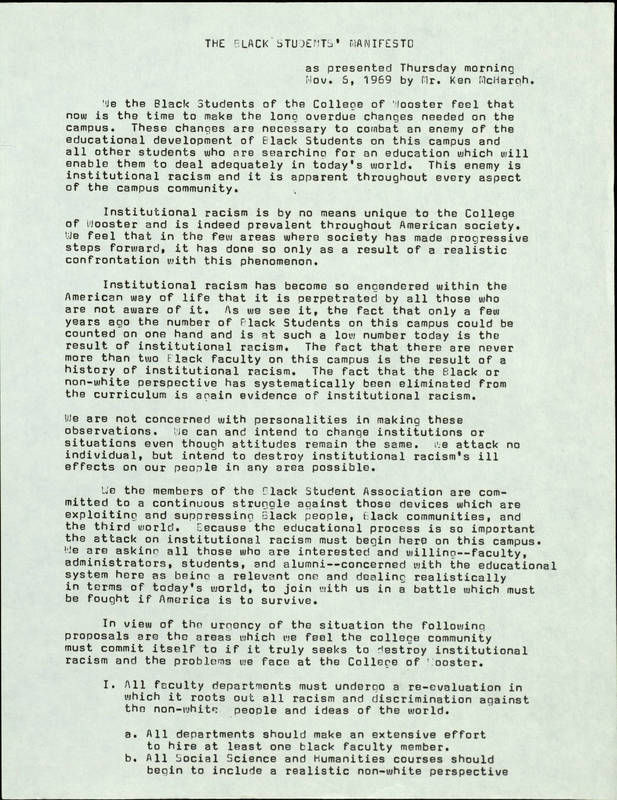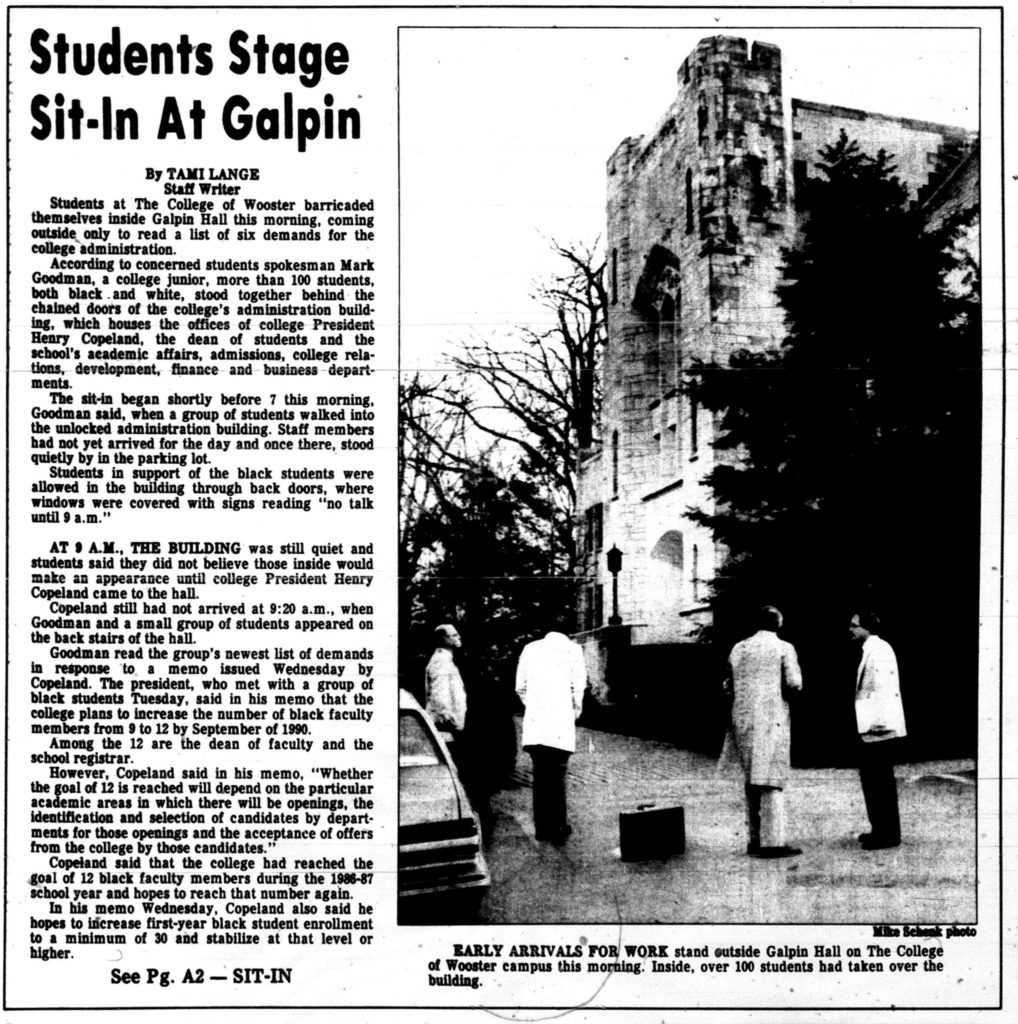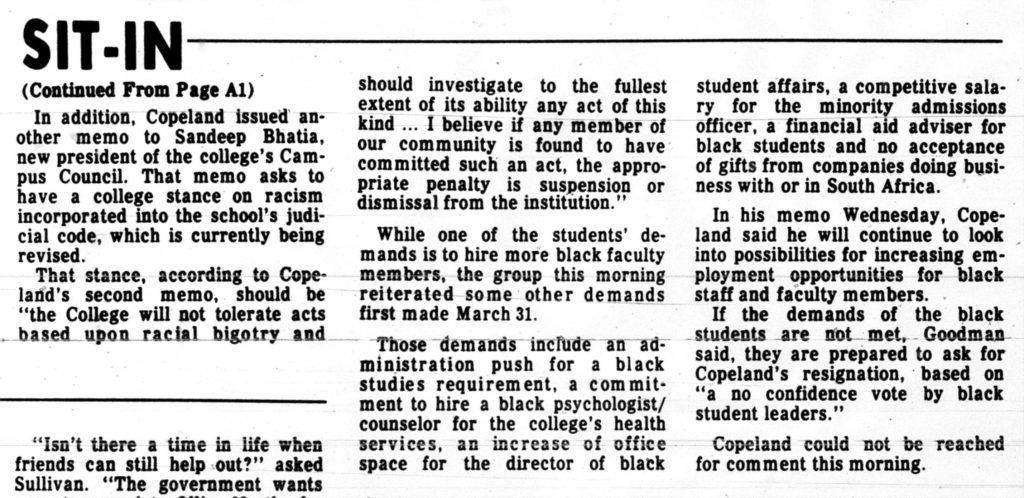African-American Activism at the College of Wooster
- Home
- The College of Wooster
- Exhibits
- African-American Activism at the College of Wooster
by Scott McLellan, revised by Jordan Wilson
The Black Manifesto

On November 6, 1969, a Thursday morning, the Black Student Association at the College of Wooster issued a declaration of change to the campus:
“We the Black Students of the College of Wooster feel that now is the time to make the long overdue changes needed on the campus…[our] enemy is institutional racism and it is apparent throughout every aspect of the campus community.”1
The Black Students’ Manifesto, now known to College historians as ‘The Black Manifesto,’ was both unique and ordinary. It was unremarkable that students, as well as faculty and administration, had already been concerned with issues of racism on Wooster’s campus. What sets the Manifesto apart from other formal statements, however, is the nature of its intentions; the student authors were sure to note that, while they were available for discussion of these concerns, “the days of idle rhetoric [were] long gone.” This is one of the first statements by Black students to show that they were tired of being put through the hoops of formal debate and administrative stalling. Unfortunately, student response to this statement was underwhelming; when asked about it in a survey by the campus paper, The Wooster Voice, few students responded to the question of whether or not to accept and acknowledge its demands.2 Many of the people who responded negatively did so because they had no idea what the Manifesto was. Fortunately, though, administration responded with the creation of a committee to address the issues addressed in the Manifesto, leading to the hiring of an admissions counselor whose mission was to increase Black student presence.3 Perhaps a distant foreshadowing of things to come, a 1980 review of response to the Black Manifesto showed that the Black campus community was rather disappointed with response to issues over the past decade.4
Pictured left: The first page of the Black Students Manifesto, known more simply as the Black Manifesto. It listed the concerns of the collective Black student community on campus and proposed solutions to address those concerns.
Boilover: The Galpin Takeover
Tensions over the treatment of Black campus community members boiled over around 7 a.m. on a Thursday in April 1989. Led by twelve black students, anywhere from 100 to 200 students took the Galpin Administration building by storm. In protest of the institutional racism students observed on Wooster’s campus, and in response to recent incidents of racially charged violence, students occupied the building, locking out deans and administrators.5 Speaking to his comrades in demonstration, 20-year old student Robert Kennedy from Pittsburgh assured onlookers that, “we do not plan on leaving this building. …We plan on staying in here until our demands are met – next week if necessary.” Having sent previous correspondence to President Henry Copeland and the administration regarding racial campus issues in need of attention, the students took action after being, “tired of…[the] situation getting lost in the bureaucracy,” of administrative response and change. After thirteen hours of protest and hours of heated discussion between Copeland and students, some of the demands for change were met with affirmative commitment, effectively ending the protest around 8 p.m. that evening.6


This is an article from the Wooster Daily Record on April 20, 1989. It covered the protest, now known as the Galpin Takeover, put on by both Black and white students after a series of violent incidences against people of color on campus. Noted as a protest with both peaceful beginnings and ends, it led to the active implementation of changes for the African American campus community.
Citations
1 Ken McHargh & Black Student Association, The Black Students’ Manifesto, November 6, 1969.
2 The Wooster Voice, May 8, 1970, 6.
3 The Wooster Voice, February 2, 1973, 1-6.
4 The Wooster Voice, November 7, 1980, 1-5.
5 “150 College of Wooster students end sit-in,” Akron Beacon Journal, April 21, 1989; The Plain Dealer, April 1989 (Cleveland, Ohio).
6 Henry Copeland, memorandum to College of Wooster Board of Trustees, April 20, 1989.
How to cite this page
MLA: “African-American Activism at the College of Wooster.” stories.woosterhistory.org, http://stories.woosterhistory.org/exhibits/the-college-of-wooster/african-american-activism-at-the-college-of-wooster/. Accessed [today’s date].
Chicago: “African-American Activism at the College of Wooster.” stories.woosterhistory.org. http://stories.woosterhistory.org/exhibits/the-college-of-wooster/african-american-activism-at-the-college-of-wooster/. (accessed [today’s date]).
APA: (Year, Month Date). African-American Activism at the College of Wooster. stories.woosterhistory.org. http://stories.woosterhistory.org/exhibits/the-college-of-wooster/african-american-activism-at-the-college-of-wooster/

